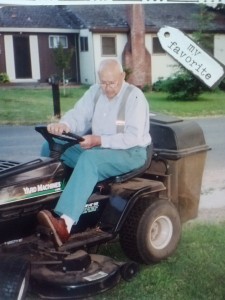Grandpa Charlie’s Life Lessons
My Grandpa Charlie was a giant of a man. He was a researcher, an explainer — oily hands, mucked up coveralls — a beanie wearing man. He tinkered, he fixed, and he taught. His words were never wasted — what he had to say could fall under one of three categories, maybe even all three at once: how respect worked, how trains worked, and how the Lord worked.
So it came as no surprise when my Grandfather, in his polyester baby blue suit, took it upon himself to address the congregation on the workings, the function, and the correct usage of a microphone. Twenty five minutes of facts, diagrams and advice in hopes that his fellow members would start using the microphone correctly, because apparently they weren’t.
“A microphone is a simple yet effective device that converts mechanical energy waves or sound into electrical energy waves. Speaking into a microphone excites the diaphragm that is coupled to a device that creates an electrical current proportional to the sound waves produced.”
Growing up in the depression, he was the original re-cycler, up-cycler, re-user and “I’ll save it later for parts” kind of hoarder. This stalwart member would buy coffee makers at garage sales “for parts.” He kept his very first washing machine “for parts.” And when he no longer felt he could safely drive, he turned in his driver’s license and bought himself a riding lawn mower.
After taking off the blades and attaching a wagon, he would drive around the suburbs of Fair Oaks, California, from yard sale to yard sale every Saturday: finagling his neighbors and negotiating them down so he could take their junk for more parts.
 “The first microphone was invented as a telephone transmitter by Alexander Graham Bell in 1876. It was a liquid device that was not very practical. In 1886, Thomas Alva Edison invented the first practical carbon microphone. The carbon microphone was used for radio transmissions and extensively in telephone transmitters until the 1970’s when they were replaced by piezoelectric ceramic elements.”
“The first microphone was invented as a telephone transmitter by Alexander Graham Bell in 1876. It was a liquid device that was not very practical. In 1886, Thomas Alva Edison invented the first practical carbon microphone. The carbon microphone was used for radio transmissions and extensively in telephone transmitters until the 1970’s when they were replaced by piezoelectric ceramic elements.”
My mother’s first car cost less than $100. After Grandpa Charlie fixed it my mom admits that it ran very well. So what that her boyfriend (coincidentally becoming her husband) would drive up to her family’s home every morning to help her start the car? It was a two person job: hit the carburetor with a hammer while the driver revved the engine. But hey, it worked.
“If you’re using a microphone stand, such as the one before me, be sure to place yourself at the proper distance. The capabilities of different equipment make different demands on the speaker, so find the position that will clearly capture and carry your voice. Speak over or across the microphone, not into it!”
Being the thrift-meister that he was, he certainly had a sweet tooth. Us grandkids would be lounging on the sectional watching the Garfield Goes to Hawaii special while he passed out jellybeans. But just one each. There were only 24 to a bag — barely enough to cover the sure vastness that were his legacy, so you only got JUST ONE.
 Seating strategies were perfected as to be the first to pick, ensuring we were not left with the one lone dreaded black jelly bean. At his funeral we had a bowl of jelly beans by the programs, with a kind but stern note that said to “Just take one!” Grandpa would be watching.
Seating strategies were perfected as to be the first to pick, ensuring we were not left with the one lone dreaded black jelly bean. At his funeral we had a bowl of jelly beans by the programs, with a kind but stern note that said to “Just take one!” Grandpa would be watching.
“To create sound, the vocal apparatus needs breath and space. Enable your voice by standing straight, aligning your head with your spine. Twisting or bending the neck puts your voice at a bio-mechanical disadvantage. By holding your head up and not looking down, you will assure that air flows out smoothly as you speak.
“By standing upright, you will improve the sound of your voice and facilitate the most effective use of the microphone. From an upright stance, you won’t be talking into the microphone, but across it. That’s what you want to do.”
Being amongst so many grandchildren, he managed to always make us feel like we were his favorite (truth be told I am still his favorite). He helped nurture my art enthusiasm with a possessed art easel, my Great-Grandmother’s oil paints (that I still use) and always keeping the pictures that I drew for him on his wall. One particular drawing of him in a train stayed on his wall ’till years after his death, when my grandmother gifted it back to me.
“Now don’t go crowding the microphone, most people get too close. Crowding the microphone will distort your posture and your voice. Don’t get so close to the mike that you could chomp a bite out of it. The microphone is designed to capture a voice that flows over or across it, not into it. If you get too close, the mike will amplify every breath, every snap of your jaw, every click and hiss of the words you pronounce.
“Crowding the mike can also create annoying feedback, popping, and screeching from which most audiences will recoil. While your listeners may tolerate one or two such incidents, they will tune you out if the problem persists.”
 When my little boy was seven years old, I got him his first real tie. As I began to loop over the ends, I told him how my Grandpa Charlie taught me. I was sixteen and watching him fiddle with his latest Father’s Day tie monstrosity when he called me over, put another tie around my neck and started teaching me to tie a basic Windsor knot.
When my little boy was seven years old, I got him his first real tie. As I began to loop over the ends, I told him how my Grandpa Charlie taught me. I was sixteen and watching him fiddle with his latest Father’s Day tie monstrosity when he called me over, put another tie around my neck and started teaching me to tie a basic Windsor knot.
“I really don’t see why I need to know how to tie this thing.”
In his infinite wisdom and his ‘no fluff’ authoritative approach (that no one would ever dare question) he explained: “Because one day you’ll need to know.”
My throat choked up as I told my little boy about the extraordinary man who helped shape my life, taught me that one jelly bean really was enough, and just because I was a girl, I did need to know how to properly knot a tie.
I don’t think my grandpa ever really thought much into it as he patiently guided me through the steps all those years ago. I don’t think the thought ever occurred to him that one day I’d be a single mom needing to tie my little boy’s tie for church. He just knew, through life’s experience, that nothing you learn is useless. There’s no such thing as wasted wisdom, and if you can learn it today you can apply it tomorrow.
“In communication, your goal is always to reach your audience. The vocal elements you build into your delivery have everything to do with achieving that goal. And keep in mind: The microphone is a tool. It won’t turn a poor delivery into a good one.”
*side note: this is not the actual talk — but my own impersonation of what it would have sounded like if I had been there coupled with my mother’s memory as a ten year old. Apparently Grandma Dorothy wasn’t too impressed and ranted on him all the way home from church.


